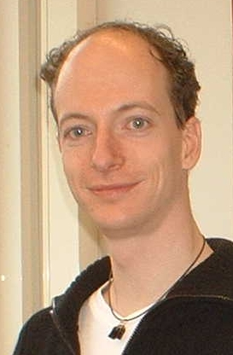Towards the hybrid organic semiconductor Fet (Hosfet)
Promotion Date: 16 March 2006
| Let me first explain about the FET or Field Effect Transistor. A FET basically works like an electronic switch; the most well known FET is the MOSFET, which forms the basic building block in computer chips. Professor Bergveld of this university was the first who took a MOSFET and modified it in such a way that it functions in fluids as a chemical sensor, able to measure the pH. This is called an ISFET (Ion Selective FET). However, if one wants to measure other substances in e.g. blood, it is very complex to modify and adapt the original ISFET to do so. My project dealt with the development of a broader application of the ISET, and for that purpose we had a close collaboration with Wageningen University, the university for life sciences, where they have expertise in attaching organic monolayers directly onto silicon surfaces. |
What was your thesis about?
Let me first explain about the FET or Field Effect Transistor. A FET basically works like an electronic switch; the most well known FET is the MOSFET, which forms the basic building block in computer chips. Professor Bergveld of this university was the first who took a MOSFET and modified it in such a way that it functions in fluids as a chemical sensor, able to measure the pH. This is called an ISFET (Ion Selective FET). However, if one wants to measure other substances in e.g. blood, it is very complex to modify and adapt the original ISFET to do so.
My project dealt with the development of a broader application of the ISET, and for that purpose we had a close collaboration with Wageningen University, the university for life sciences, where they have expertise in attaching organic monolayers directly onto silicon surfaces.
What’s the advantage of such monolayer?
When working with silicon based chemical sensors there is usually an intermediate oxide layer present. But in Wageningen they can attach carbon chains directly onto the silicon surface. The carbon on the silicon should have the same insulating properties as the oxide. For organic chemistry purposes the carbon is extremely suitable: it is very cheap, receptors can be easily attached to the carbon chains, it reacts quickly and there is no need to have clean room facilities to make them. Together we worked on the development of the HOSFET: the Hybrid Organic Semiconductor FET.
What was your share in it ?
I implemented the silicon carbon layer in a working electronic device. First of all I had to find out how a carbon layer behaves electronically. So we sandwiched the device in between two metal layers and performed standard current-voltage and capacitance-voltage measurements. These showed that a current passes through the carbon layers with mathematical precision. It showed that by adapting the thickness (between 1 and 2,5 nanometer) of the monolayer, you can exactly determine the electronic properties. This was quite a nice result, which led to a publication in Chemphyschem. The only major setback is that the monolayer cannot resist high temperatures, which limits its applicability in combination with high temperature processes.
But how far are we off of a real biochip?
Difficult to say as yet. We still have to establish with more certainty if the layers are behaving in a fluid as we hope they do. It looks all right. We also have a strong indication that we can introduce substances on the layer reacting with sodium and potassium. So it looks promising. I am very pleased that I myself can do the follow-up on the recommendations in my thesis for further research. I am going to do a postdoc on the subject, again in close collaboration with Wageningen University.
What did you like best about your research?
I was completely free to conduct my own research. That has led to unexpected and surprising results. Through perseverance and hard work you are getting somewhere.
I also liked working on a device that may be of potential importance for humankind.
Any moments of despair?
Of course. I think everybody has that. Especially in the second year I was groping in the dark, did not have any sense of direction. A certain amount of scientific intuition and faith helps you out I can say afterwards.
Any plans for the future?
I don’t know yet what I will do after my postdoc. I will let myself be inspired by whatever comes my way that is how it often goes. But I would like to stay in research and do something with social relevance. That is a big driving force for me.

